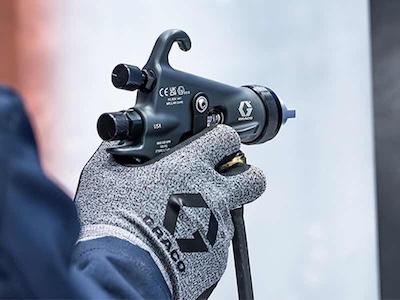Wendy Hartley from Graco discusses the Stellair ACE and Stellair, which the company says are the only industrial air spray guns that have achieved Ergonomics Performance Certification.
The company says that advanced testing by United States Ergonomics proves that the manual pressure feed sprayers reduce fatigue potential, increasing productivity for industrial painters.
“When we started the project, we wanted to make sure that we built a gun that painters would be happy using,” Hartley says. “We tried to build in ergonomics before, but we wanted an outside company to let us know what we needed to do to have an ergonomic gun. Our engineers understood balance and body shape, but we wanted an ergonomic gun that painters would happily use.”
 She says the first step was to send legacy guns to the ergonomics company and have them evaluate the equipment. They got painters involved with the testing, using sensors on their arms, wrists, shoulders, and elbows to gain statistical insight into what was comfortable for an operator.
She says the first step was to send legacy guns to the ergonomics company and have them evaluate the equipment. They got painters involved with the testing, using sensors on their arms, wrists, shoulders, and elbows to gain statistical insight into what was comfortable for an operator.
“They also interacted with the operator and asked them where they felt pressure points on their hands and stress on their muscles and which applicators made them feel good and which ones didn't,” Hartley says. “The evaluation was the first step, and then the engineers took that information and built it into the spray guns.
Due to its carbon-reinforced polymer construction, Stellair ACE weighs 209 grams (7.4 ounces)—up to 50% lighter than almost any manual pressure-feed spray gun. It uses up to 25% less muscle effort than comparable industrial air spray guns.
Stellair, with its aluminum metal construction, weighs 410 grams (14.46 oz), making it among the lightest industrial spray guns available. Compared to similar air spray guns, Stellair lessens muscle exertion by up to 18%.
The company says reducing weight was not the only ergonomic advancement factored into the new spray gun design. Graco engineers also focused on minimizing hand pressure points, improving overall gun balance, and enhancing hose flexibility. Research and testing by United States Ergonomics allowed them to objectively measure the improvements.




































